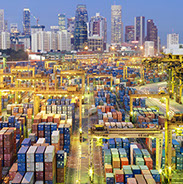Looking Ahead
Financing Sustainable Development
A Crucial Year
Financing for Development
Since the adoption of the United Nations Millennium Development Goals in 2000, the majority of developing economies have made important progress in terms of achieving strong growth and reducing poverty. But progress has been uneven, with outcomes weakest in fragile and conflict-affected states. The challenge now is to build on the strong results of the past 15 years, with a focus on tackling obstacles to sustainable growth and inclusion, most notably in countries that have fallen behind.
The international community is being called upon this year to commit to a shared vision of development goals through 2030 and beyond, and an action plan to make this vision possible. Achievement of these Sustainable Development Goals (SDGs)—which encompass economic, social, and environmental themes—will require a partnership among developed and developing economies, and international institutions. Most important, it will be essential to ensure that the right policies are in place and that sufficient private and public resources are mobilized to achieve the SDGs.
The IMF, with its global membership and mandate to operate at both bilateral and multilateral levels, is uniquely positioned to contribute to and help implement this compact. The Managing Director outlined the IMF’s goals to the 2015 Spring Meeting of the International Monetary and Financial Committee in a document titled “Financing Sustainable Development: Key Policy Issues and the Role of the IMF.” The paper was discussed with the IMF Executive Board in an informal session in April, prior to the International Monetary and Financial Committee meeting.
Implementing the Post-2015 Development Agenda: A conversation with IMF Managing Director Christine Lagarde
The IMF’s work for the 2015 Development Agenda is focused around the agenda of three major United Nations conferences during the year:
Financing for Development (Addis Ababa in July), which will develop a shared view on the policies needed to generate the resources to achieve the SDGs
UN Summit on the SDGs (New York City in September), where the SDGs will be formally adopted
UN Climate Change Conference (Paris in December), to reach a global agreement on national targets for reduction of carbon emissions
Paving the Way to Prosperity
Also in:عربي
Español
As deliverables for this crucial development agenda, the IMF is considering the following areas of action, as outlined in the Managing Director’s statement to the IMFC:
Seeking options to boost access to IMF resources provided to developing countries, thus better positioning them to handle balance-of-payments needs as they pursue growth
Expanding diagnostic and capacity-building support for countries seeking to scale up investment to tackle infrastructure gaps
Sharpening the focus of operational work on equity, inclusion, gender, and climate issues, drawing on ongoing analysis and work of other institutions
Increasing the focus on and provision of resources to work on fragile and conflict-affected states
Selectively expanding capacity-building efforts in the areas of revenue mobilization, energy taxation, and financial market development.
- Fiscal Work in Progress
-
Important work in the area of fiscal policy was undertaken during FY2015 that led to Executive Board consideration of policy papers in FY2016. Two papers in particular— prepared by the Fiscal Affairs Department—were the focus of Board discussions:
Fiscal policy and long-term growth: This topic is a core theme of the IMF’s Global Policy Agenda (see Part 1), which focuses on strategies to lift economic growth across the IMF membership in the wake of the 2008 global financial crisis. A paper prepared in FY2015 identifies the main channels through which fiscal policy can influence medium- to long-term growth. It distills practical lessons for policymakers by drawing on the IMF’s extensive technical assistance on fiscal reforms, a vast literature, and a multipronged analytical approach.
Making public investment more efficient: The paper builds on previous analytical work on public investment issues, including in the October 2014 World Economic Outlook, and examines how countries can improve the efficiency of public investment and increase the effects of public investment on growth. Key findings of the paper include: (1) the economic impact of public investment critically depends on its efficiency, and there are large inefficiencies in public investment processes; (2) the economic dividends from closing the public investment “efficiency gap” are substantial; and (3) strengthening specific key institutions that shape the planning, allocation, and implementation of public investment could close most of the efficiency gap, but reform priorities vary across countries.








